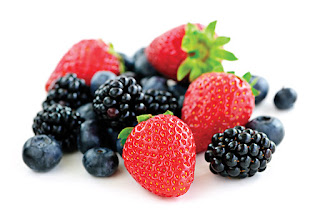Thanks giving may be the only time many of us are aware of the influence of Native American foods on what we eat. Yet, if some dietitians and devoted cooks had a say, that would change.
That's because traditional American fare -- from North, Central, or South America -- contains a rich and colorful palate of heart-healthy foods, such as beta-carotene-packed pumpkin, fiber-loaded beans, and antioxidant-rich berries.
"Traditional Native American food [is] as varied as the Americas from which it originated," Harold H. Baxter, DDS, author of the pending book Dining at Noah's Table, tells Web MD.
Yet it's all too easy to overlook Native American fruits and vegetables in our modern diets, experts say.
"We just don't eat enough of most of these [traditional] foods any more," says David Grotto, RD, author of an upcoming book on eating traditionally called 101 Foods That Could Save Your Life.
"Our cupboard used to be our medicine cabinet. A solution to a lot of what ails us may be getting back to these traditional foods."
Here are five familiar Native American foods that would make healthy additions to any diet:
1. Corn
Traced back to Central and South America, corn has served Native Americans as both drink and diet staple; its husks as dolls, masks, even fuel. Along with squash and beans, corn makes up the revered trinity many Native Americans call "The Three Sisters," vegetables frequently sown together.
"The corn provided a stalk for the bean vines to climb around, and the beans returned the favor by replacing the nitrogen in the soil," Chief Roy Crazy Horse writes in an article on the Powhatan Renape Nation's web site. "The squash spread out its broad shady leaves to keep other plants from crowding out the corn."
Corn is also nutritious, containing vitamins C and K, phytochemicals, B vitamin, and fiber. Another bonus: Corn just may help to prevent cancer.
"One of corn's phytochemicals, cryptoxanthin, was shown in one study to offer a 27% reduction in lung-cancer risk," says Grotto, who is also a spokesman for the American Dietetic Association.
Indigenous recipes for this ubiquitous food include sweet corn soup and chowder, cornbread, and popcorn. Enjoy ears fresh or roasted, and cut corn into salads or wraps. And try different colored corn when it's available -- those colors represent different body-boosting phytochemicals.
2. Berries
Growing wild across many parts of America, blackberries, strawberries, blueberries, and raspberries played a part in many native diets, including those of the Natchez and Muskogean.
Serving up healthy portions of fiber, vitamins, and minerals, berries have been shown by some research to help protect against stroke and heart disease. While blackberries and raspberries have nearly double the fiber of strawberries and blueberries, a cup of strawberries contains more vitamin C than you'll need in a day.
"Blackberries, raspberries, and strawberries also contain several types of bioflavonoid phytochemicals,
"Blackberries, raspberries, strawberries, and blueberries contain some phenolic acid phytochemicals," too, Magee adds. "These phytochemical families (bioflavonoids and phenolic acids) have powerful antioxidant duties in the body and may help protect us against cancer."
Berries appear in Ojibwa and Sioux recipes for teas, puddings, and berry soup. You can also try mixing them into your own signature berry jam, as Mage does, or in pies, cakes, and muffins, and over hot or cold cereal.
3. Pumpkin
"There's so much goodness in it."
Case in point: Just one cup of pumpkin is packed with potassium and fiber, and has more than 300% of the Recommended Daily Allowance of vitamin A. It's also rich in the antioxidant beta-carotene, which may help slow aging and reduce problems related to type2 diabetes, according to the American Dietetic Association.
Oneida recipes for pumpkin and squash include cranberry pumpkin cake and silky winter squash soup. You might also include pumpkin in stews, or try a Grotto trick for this bright treat: Carve mini pumpkins, stuff with red potatoes, then roast them. "Kids love them that way,"
4. Mushrooms
Mushrooms aren't usually thought of as especially nutritious. And while it's true they're not very nutrient-dense, that shouldn't be the only way we look at a food's value.
"If you look at the antioxidants in mushrooms, they're just wonderful," he says.By helping to war off damaging free radicals -- molecules that may play a role in the development of heart disease and cancer -- antioxidants are what make mushrooms shine.
Even the lowly white button mushroom brings a lot of antioxidant pop to the table, as well as glucans, which may help lower cholesterol.
While picking wild mushrooms is a hobby only for the well-informed, you can enjoy traditional foods with mushrooms found at the supermarket.
"Try a grilled Portobello and teriyaki sandwich instead of meat,". Mushrooms can also take center stage in sauces, stir-frys, soups, pates, and spreads. Or savor them over acorn squash with sage and onion -- a perfect fall treat.
5. Beans
Completing the three sisters trinity, beans were a staple of the Navajo, Creek, Iroquois, and others.
Tiny nutrient powerhouses, beans like black, red, and pinto pack a healthy punch. Along with being fiber-rich, they're good sources of cardiovascular-boosting potassium, B vitamins, and folic acid. An excellent low-fat source of protein, they're cholesterol-free, too.
Reporting on a study that rated 100 foods for their disease-fighting antioxidant capacity, small red beans topped the list, with red kidney beans and pinto beans following in third and fourth place. Black beans showed up in the top 20.
Traditional ways to enjoy them include succotash and bean salad. Beans of every stripe can also find their way into chili, soups, burritos, and tacos.





Comments
Post a Comment